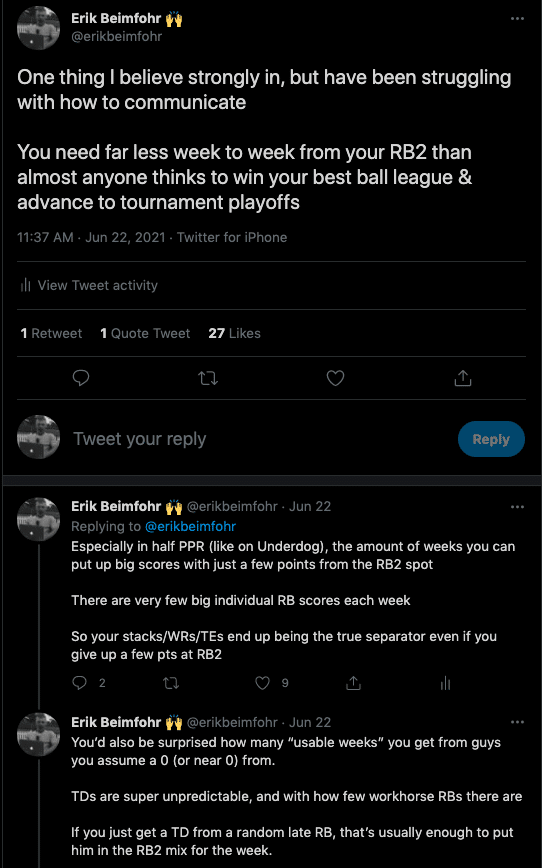I was so tempted to call this the “Modified Hyper Fragile Strategy”, but I didn’t want to ruffle too many feathers. Regardless, I think 2021 drafts have presented some really interesting opportunities for those of us thinking with a tournament mindset. The biggest one that I’ve uncovered after getting through my first 75+ Best Ball Mania II drafts on Underdog is this idea of “Hyper Fragile” roster construction, specifically as it relates to running backs.
The Running Back Thirst
Mike Leone and Justin Herzig of Establish The Run brilliantly pointed out last draft season the incredible upside of a hyper fragile approach to the RB position. Hammer it early (typically with 4 backs) and be done. Assume you hit on those RBs (and they stay healthy), and you can cover the WR position through quantity (with 9, 10 or even sometimes 11 WRs on your 18 man roster).
It makes a lot of sense intuitively, and it actually ended up being very successful last year. So much so that Herzig actually won the main Underdog tournament from last year for a cool $200k using the strategy. However, as often tends to happen, the field has picked up on last year’s successful strategy. This has driven up the cost of early running backs a ton while simultaneously reducing the number of RBs being taken overall AND pushing down some viable RBs into the last couple rounds. To be clear, every year the market has an incredible thirst for early round RBs, but this year the extent to which our opponents are loading up early and ignoring later round guys is definitely more drastic than ever.
To make matters worse, with so many people taking more WRs than year’s past and needing to take more of them in the late rounds of drafts, you’ll reach a certain point in every draft where the fall off in WR quality is STEEP.
I’m not bringing all this up just to show you how big of a running back problem our competitors have (though that part is true), but after going through many of these drafts for a couple months now, it started to finally sink in how to process it.
The overarching concept of the Hyper Fragile build is great. We know we want to embrace fragility in these tournaments, and doing so at RB can allow us to load up on other positions to gain points on our opponents. But if all our opponents are onto the same strategy, or if they’re soaking up so many of the early RBs that it starts to kill the supply for taking 3-4 quality RBs early, then it actually becomes super -EV to try to follow that same playbook.
Still, the benefits of that roster construction do exist, so how can we take advantage of that in this current draft climate specific to this draft season?
Enter the 2021 Hyper Fragile build
(Taking a super quick aside – I actually don’t think the construction of 3-4 early RBs is really that fragile at all. I’d argue it’s the opposite of fragile to have those stud RBs to bank on even though it feels fragile because you didn’t draft a lot of them. But that’s a discussion for another day.)
This year I think the power of this hyper fragile build might be even greater, especially given the significantly larger contests we are competing in compared to last year. This year’s Best Ball Mania II is about 5 times larger than last year’s contest, so upping the fragility clearly makes sense just from that standpoint.
When you add that to the above described RB landscape, I think combining the hyper fragile approach (very limited quantity of RBs) with the Hero RB/Anchor RB approach (one stud RB to lock down one RB spot, then piecing RB2 together later in drafts to load up elsewhere) is the dream approach for this year.
Here’s why –
First, I think the market as a whole overvalues what you need from the RB2 position in order to win your league and advance to the best ball playoffs. I tweeted about it a couple weeks ago –

You can’t be taking zero’s at that spot all year, but considering the low bar for the amount of points you need week to week, it sets up perfectly as the roster spot to take on the most fragility. Since our opponents can’t separate from us at that position very easily (if at all), we can take on additional risk there in order to shoot for more upside both at the RB2 spot, but also in the rest of our roster.
Essentially, we know we have to get lucky to win one of these huge tournaments anyway, so we should be looking to get lucky at spots like RB2 where our opponents are investing heavily but will struggle to gain points on us even with that investment.
And by still drafting that Hero/Anchor running back, you’re not sacrificing points entirely at RB. In fact, the ceiling scenario is that you’re even gaining points at RB1. Obviously, this works very well with the 1.01 like Christian McCaffery, but it fits any early stud RB. I even like to push the limits of it a bit with a first round Kelce/Tyreek/Diggs, and then come back with Mixon or Antonio Gibson in the 2nd to make them my anchor. You’re simply making a bet on whichever stud RB you take in the first couple rounds being a fantasy star. If CMC is the RB1, or if Gibson breaks out and contends for the RB1, you’re gaining points at your first RB position on your roster over your opponents.
Then, if we stick to our draft motto – “Draft as if you’re right” – we get the massive advantage of being able to load up at every other position (QB/WR/TE). Doing this sets you up to gain points at basically every other position besides RB2. And that’s the case because it’s counter to what our opponents are doing. Through the first 7 or 8 rounds, our opponents have almost always loaded up on RB with 3 or 4 guys. As we speak, I’m in an Underdog draft where every other team besides myself and one other had 4 RBs through 8 rounds. So naturally, if we have just 1 RB and 7 picks between QB/WR/TE compared to just 4 by our opponents, we are going to build better teams at those positions… simply by “sacrificing” at the one RB2 spot. However, from a seasonal perspective, I don’t think we are truly even sacrificing.
Because everyone is hammering so many RBs early, it’s naturally pushing down the mid to later tiers of RBs into later draft rounds. Everyone has so many early RBs, there comes a point in the draft where they need to start scooping WRs. So this has created a lot of RB “value” in drafts. Every draft is a little different in terms of how that plays out, but in my experience it’s most often once you get into the double digit rounds. Occasionally a Raheem Mostert or Damien Harris type will fall, but it’s usually in the tier(s) after that.
In that next tier, you have a combination of committee backs and “handcuff” types. Whether it be Gus Edwards, Latavius Murray or Darrell Henderson, all these backs have value in different ways. Guys like Gus will have clear immediate roles, but probably lack the true ceiling even if an injury occurs, whereas Latavius has some standalone value, but is competing for top 5 RB overall if Kamara were to go down. I’m not here to tout my favorites there (just kidding – it’s the upside guys like Lat and Henderson), but the real point is that this tier is strong. Most of these guys aren’t total zeros even if no injury occurs, and they even offer some spike week upside, combined with a huge ceiling if things shake out their way.
This tier of guys is ideal because they are allowing you to still pick up some points at RB2 with the occasional spike week combined with the huge ceiling we are looking for. In this build, we know we are sacrificing at RB2 early in the season, but if we select the right types of players, we can more than make up for that with their ceiling scenarios. If Latavius pops for a couple of spike weeks in the first 2 months of the season, and then Kamara goes down in week 8, you’ve successfully tread water at RB2 and now have a 1st round RB as your RB2… drafted in the 12th round.
So, we know that early double digit round tier is super valuable because of this combination of usability and upside. But the super late rounds have become nearly as valuable this year too.
Again because of the early RB thirst, the robust RB builds and the chasing last year’s success, the field is really hammering late round WRs. They’ve loaded up on early RBs, and they just need quantity of WR by the last 3 rounds. That has left a tier of incredible values at RB… values that would not be there in year’s past. Part of that also has to do with uncertainty, but you have backups to a huge percentage of the 1st and 2nd round RBs going in the last couple rounds of the draft. Some are pure handcuffs (Chuba Hubbard), and some should have some small roles in the offense (Darrynton Evans) whether it be passing downs or just a couple series per game (Samaje Perine). Even the Giants have told us that Saquon is probably going to give up some snaps early in the year as he returns from injury, and Devontae Booker sometimes goes undrafted.
Anyway, you get the point.
These handcuffs like Tony Pollard, Henderson and Latavius go much earlier in drafts because we have certainty around their workhorse status if the starter were to go down. They should go ahead of these less certain guys, but in year’s past these other handcuff types would certainly never be going undrafted, and they’d definitely be going before the last round even with some of the uncertainty around those backup situations.
We don’t know exactly which guys are going to pop from this group, but every year guys emerge as legit fantasy options, whether it be for small stretches or large. People always think about it only in the season-ending injury type situation, but it can be a short term injury in the right weeks as well. Zeke didn’t miss extended time last season, but in the one game he did miss Tony Pollard dropped 130 total yards and 2 TDs, which just so happened to be in the Best Ball playoffs. Ultimately, we are just looking to get lucky and find a huge payoff when that happens. These types of players are available for us late with huge payoffs due to the way our opponents are approaching 2021 drafts. Meanwhile, if you’re looking for WRs in the last round, you’re debating between Kendrick Bourne and Hunter Renfrow. These late round WRs have potential for a couple usable weeks here and there, but there are absolutely zero paths to real upside.
Real Life Example
Let’s talk through an example from a recent draft I completed. Pictures are worth a thousand words and all that.
The 1.01 teams always look better, but whatever, it proves the point well.

You can see how using CMC as my Hero/Anchor RB and pushing the rest of my RBs down beyond where my opponents are drafting enables me to load up elsewhere. I have the best WRs in this 12 man league, and I was able to secure two strong high upside QBs in Russ + Lance, while also getting an elite high upside TE in Kyle Pitts.
Then, I just hammered 4 RBs to fill out the position with these high upside mid to late round guys. I know that I’m sacrificing a little bit at RB2, but I’m also not getting absolute zeros with really any of these other 4 RBs. These guys are going to be on the field, so since I assume I am using CMC’s score at RB1 every week, if I can just scrape by until I get lucky with one of these backups (likely due to a starter’s injury), I am giving myself outs to blowing away my competition by gaining at every single position. And we know TDs are unpredictable, so you still have outs to some TD luck at RB2 even before you access the true ceiling of one of those backups.
Add in your stacks and you’ve got what I believe to be the best way to take advantage of the current drafting climate. The running back thirst is absolutely real this year, and it has created a unique draft environment that tournament players like us can use to our advantage. Many are looking for what worked in the past or other cookie cutter draft strategies, but the key is to remember we are playing a game for this year, with this pool of players and this draft environment. What happened last year is unlikely to happen this year. The main thing we can do to get an edge on our opponents isn’t in any past strategy concept, but it’s in analyzing what our opponents are doing and crafting our teams in the way that best leverages the assumptions behind their draft plans. I think that’s what this style of drafting will do, and it will also give us the appropriate amount of upside we need to win these large field $1 Million to first place tournaments.





